Summary of Ambroise Vollard
Through a combination of intuition, enthusiasm and business acumen, Vollard helped shape the careers of a number of seminal artists, and in so doing, claimed his own place in the evolution of early European modernism. Perhaps best known as the dealer who "discovered" Paul Cézanne, he forged many other important professional relationships (though not all of them happy) with artists of the calibre of Paul Gauguin, Pierre-Auguste Renoir, Edgar Degas, André Derain, Maurice Denis and Pablo Picasso. In addition to his love for painting, Vollard was one of the few dealers of his day to take the graphic arts seriously. He became a driving force behind the promotion of the Nabis group whom he mentored as they moved into new mediums; most notably the dormant sphere of color lithography. Vollard also developed a passion for book publishing. As the respected author of monographs on Cézanne, Degas and Renoir, and by raising the bar of the print album to create what would become the deluxe Livres d'Artiste book, he played no small part in expanding the international reputations of some of early modernism's greatest pioneers.
Accomplishments
- With his groundbreaking 1895 Cézanne exhibition, Vollard not only "announced" the influential painter to a whole new generation of post-Impressionist artists, he also set a new precedent by demonstrating a way in which artistic reputations could be made in commercial art galleries rather than through formal, highly publicized, public exhibitions. The Cézanne exhibition amounted to an afront to the art establishment, and Vollard took great personal pride in his career-spanning reputation as an anti-establishment figure.
- Vollard completely reinvigorated the process of lithography. Dispensing with the services of professional engravers, he commissioned original prints from his artists, such as Degas, Derain and Denis, with the effect that the art print commanded a new level of respectability (and a higher commercial value too).
- Vollard's input was such, he might justifiably be called the fourth member of the Nabis Group. The Nabis, made up of Denis, Pierre Bonnard and Édouard Vuillard, took their initial inspiration from Paul Gauguin but following their consecutive group exhibitions (1897 and 1898), Vollard pushed the three artists to experiment in new mediums, most notably in book illustration and color lithography. The resultant albums were considered the very apex of turn of the nineteenth century publishing.
- Vollard created controversy by sending artists overseas to paint. Through his involvement with painters such as Derain and Maurice de Vlaminck (both of whom travelled abroad) Vollard demonstrated his ambition to diversify his artists' range of subject matter. The policy had the further benefit of raising the artists' profiles on the international stage too.
The Life of Ambroise Vollard
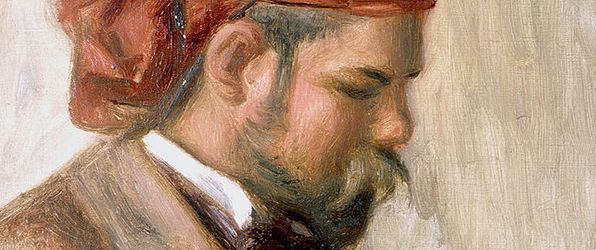
Having happened upon Cézanne for the first time, his landscape hiding in plain sight in the window of "a little color merchant in the rue Clauzel", Vollard experienced something akin to an epiphany: "It was as if I [had] received a blow to the stomach", he recalled.
Ambroise Vollard and Important Artists and Artworks
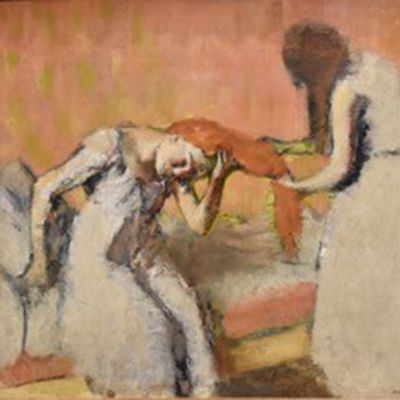
The Coiffure (1892-95)
Degas first made Vollard's acquaintance in 1894 when he attended the dealer's first exhibition. Soon after, the artist was supplying Vollard with pastels and drawings in exchange for pieces by Cézanne, Gauguin and Manet. It was only following Degas's death in 1917, however, that Vollard became aware of The Coiffure, purchasing it for 19,000 francs in a posthumous auction of Degas's works. The Coiffure is one of several paintings Degas made of women self-grooming. Speaking of the work's importance, curator Asher Ethan Miller argues that it ranks as one of the artist's "most impressive late oils [and] belongs to a series focusing on the intimate theme of women combing their hair that Degas explored in all media from the mid-1880s until the early twentieth century".
Vollard's acquisition of the painting demonstrates the efforts he made in furthering his clients' reputations beyond France. According to Miller, "Vollard tried to place works by Degas with museums outside France when he could [and it] appears to have been Vollard who made the sale [of this painting] to the Nasjonalgalleriets Venner, a group founded in 1917 and dedicated to acquiring major works for the Oslo museum". Vollard further promoted Degas's reputation by producing a series of ninety-eight reproductions of his works in 1914, which has been referred to as the "Vollard Album", and through a monograph on the artist which he published in 1924. These published works, combined with the poet Paul Valéry's 1938 treatise on the artist, secured Degas's international reputation and gave the public an insight into the life of a most private artist.
Oil on canvas - Collection of The National Museum of Art, Architecture, and Design, Oslo, Norway
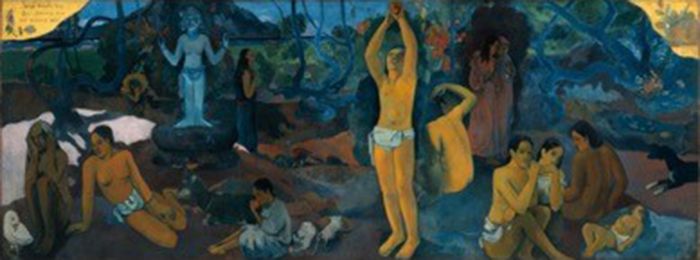
Where Do We Come From? What Are We? Where Are We Going? (1897-98)
Suffering from depression (not helped by his loathing of Vollard) Gauguin was contemplating suicide when he created this masterpiece. Featuring several Tahitian women in a tropical setting, the painting reflects the stages of one's life and corresponds to the questions in the work's title; perhaps the very questions Gauguin himself was pondering in his moments of despair. Where one "comes from" can be seen in the image of the young baby resting in the far-right foreground of the painting who is at the start of her life. The struggle of what one "should become" is manifest in the figure in the center of the painting who stands arms raised above her head looking upwards as if the answer lies with God. Lastly, the question of "where one goes" at the end of one's life is explored through the wise (gray haired) woman seated in the far-left foreground.
Gauguin and Vollard's relationship was tempestuous at best; the artist even referred to his dealer as "a crocodile of the worst kind". The men had met in 1893 while Gauguin was struggling to find a dealer to take on his new Tahitian works. Vollard, then a newcomer, was (like other dealers) put off by the exotic nature of the works, though he was an admirer of Gaugin's pre-Tahitian works. In 1895, Gauguin set sail for the South Seas once more and, in desperate need of funds, he sold Vollard some of his ceramics and canvases (and some canvases by van Gogh) at bargain prices. The forced sale stuck in Gaugin's craw who, in an attempt to dispense of the future services of Vollard, left his collection in the care of friends who he hoped would sell his work to serious collectors, at their proper value, and forward him the proceeds. His plan failed and, somewhat by default, he became dependent on Vollard to market his art.
In November 1896, Vollard held an exhibition featuring some of Gauguin's Tahitian paintings. The artist was less than happy with the situation and, having completed his new series of canvases, which included Where Do We Come From?, Gauguin wrote to his friend Daniel de Monfreid in Paris in the hope he could find him a more reputable (as he saw it) dealer. It proved a forlorn wish and Gauguin was alarmed to learn that Vollard was to take charge of the exhibition which opened in the fall of 1898. Vollard had effectively "cornered the market" for Gauguin works. With no other viable options, Gauguin signed a contract with Vollard who became the artist's principal dealer. The two men fought over the future direction of Gauguin's career but this conflict stimulated the artist to explore new areas of experimentation. And despite Gauguin's profound misgivings, Vollard's dealership proved critical in supporting the artist during the latter years of his life.
Oil on canvas - Collection of Museum of Fine Arts, Boston
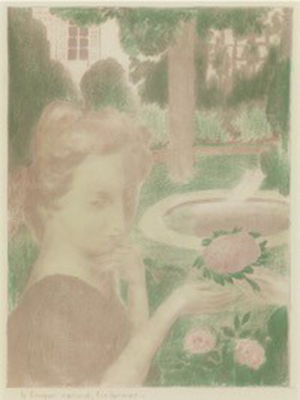
The Morning Bouquet, Tears, plate 3 from Amour (Love) (1898, published 1899)
This lithograph, one of thirteen in Maurice Denis's Amour series, features a woman in the front left foreground looking down as she reaches out for a pink flower with her right hand. She stands in a garden with a house partially visible in the distance. Rendered in pastel shades, the curator Cathy Leahy picked out, "the heightened colours, reductive form and emotional content of the prints [that] are characteristic of Denis's art of the 1890s and reveal his engagement with Symbolist ideas". The prints had deep personal meaning for Denis who, as curator Gloria Groom explains, conceived of the album as "a 'record of courtly engagement' to his fiancée Marthe, whom he married in 1893". She adds that Amour amounted to an "illustrated poem, insofar as each print is accompanied by evocative captions taken from the private notes of the artist, written from June 1891 through 1893". And if one is aware of the underlying motivations for the series, one is left to imagine the contemplative woman depicted in the print is probably thinking about the man she loves (Denis).
One aspect of Vollard's legacy was to revive interest in the process of lithography. According to art historian Jonathan Pascoe Pratt and museum director Douglas Druick, early on in his career, "Vollard became interested in the idea of commissioning and publishing original prints by contemporary artists", and, in a move that lent them greater status (and commercial value), he insisted that his painters make their own prints rather than having the work done by professional engravers. Denis's work provides a prime example of the prints Vollard commissioned and, in Leahy's opinion, this suite of lithographs in particular, was "one of the great print albums produced in Paris in the 1890s".
Color lithograph - Collection of The Art Institute of Chicago
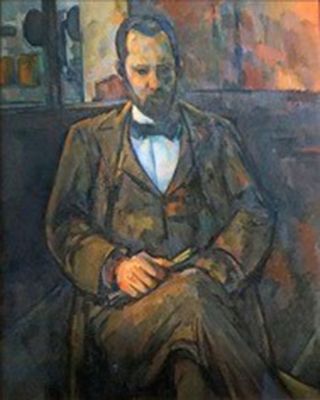
Ambroise Vollard (1899)
The art historian Robert Jensen highlighted the historical significance of Vollard and Cézanne's partnership when he observed that Cézanne "was the first important French artist to forge his reputation within the context of a commercial gallery rather than through public art exhibitions". Indeed, Vollard's Cézanne exhibition of 1895 made the artist's name overnight. The event also sealed a professional relationship that would make Vollard a wealthy man and set Cézanne on the path to becoming one of the most influential painters in the history of modern art.
Vollard was known to be a shrewd businessman who was often accused of exploiting his artists. Unlike Gauguin, however, Cézanne was happy to enter into a contract with Vollard (he would in fact handle about two-thirds of Cézanne's entire output over the course of his career) to whom he attributed his success. Indeed, he described the dealer as a "sincere man".
Cézanne's portrait features Vollard dressed in a brown suit and bow tie, seated with one leg crossed over the other and his hands resting in his lap. He wears a serious expression and the portrait is rendered through the loose, strong brushwork that are so characteristic of Cézanne's style. Seven years after it was created, the art critic J.F. Schnerb saw the painting on display in Vollard's shop, praised it as "very complete, very solid" and wondered what other modern portrait was fit to "be hung at its side?". Several artists painted portraits of Vollard, but Cézanne's is probably the first and is the only one known to have been commissioned by the dealer. It was in fact treasured by Vollard who, by Dumas's account, held on to it until his death and duly "bequeathed it to the Musée du Petit Palais" (one of only a few works from Vollard's vast collection specifically designated by name in his will).
Oil on canvas - Collection of Petit Palais, Musée des Beaux-Arts de la Ville de Paris, Paris
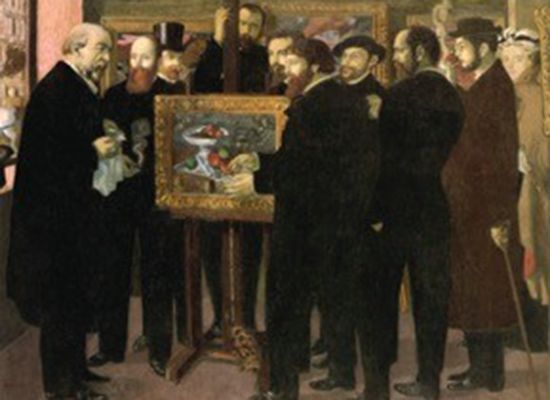
Homage to Cézanne (1900)
Homage to Cézanne is a visualization of the process of viewing a painting. The Musée d'Orsay described the picture's setting as follows: "Maurice Denis has assembled a group of friends, artists and critics, in the shop of the art dealer Ambroise Vollard, to celebrate Paul Cézanne, who is represented by the still life on the easel. This painting, Fruit Bowl, Glass and Apples [1879-80] had belonged to Paul Gauguin, who is also evoked among the tutelary examples to whom Denis is paying homage. Effectively, a painting by Gauguin and another by Renoir can be made out in the background. Odilon Redon is also given pride of place: he is shown in the foreground on the far left and most of the figures are looking at him. He is listening to Paul Sérusier who is standing in front of him. From left to right, we can recognise Edouard Vuillard, the critic André Mellerio in a top hat, Vollard behind the easel, Maurice Denis, Paul Ranson, Ker-Xavier Roussel, Pierre Bonnard smoking a pipe, and lastly Marthe Denis, the painter's young wife".
Vollard had acquired three pieces by Denis in 1893 and, through him, became closely associated with a group of avant-gardist who went by the name Nabis (the Hebrew word for "prophet"). The Nabis, made up of Denis, Bonnard and Vuillard (all pictured here) were active between 1892 and 1899 and were devotees of Gauguin; following his example of an art that conveyed ideas and emotions through an explosion of color and form. Vollard held two successful Nabis exhibitions in 1897 and 1898 but he was keen to push the three men to experiment in other mediums such as painted ceramics, sculpture, book illustration and color lithography. It was in fact their lithographic albums that proved most successful; producing results that are considered the highest achievement in color printmaking during the 19th century.
Today Homage to Cézanne serves as a memorialization of the Nabis group given that by the time Denis's painting was first exhibited, the Nabis had, according to curator Gloria Groom, "ceased to exist as a coherent movement and had found other dealers to represent them". Nevertheless, it was Vollard who "helped to shape their careers at important turning points" and as such the painting can be read as much as an homage to the dealer himself as it is the artists that formed the movement.
Oil on canvas - Collection of Musée d'Orsay, Paris
Charring Cross, Bridge, London (1906)
André Derain's painting captures a famous sight in London, that of the Charring Cross Bridge. Rendered in loose, quick brushstrokes, the work is a celebration of colors including the blue of the bridge, the green of the buildings in the background, and a swath of shades of yellows and oranges capturing the reflection of the sun on the water.
This work is an important example of a series of thirty paintings Derain painting between 1906 and 1907 of London. Through his exhibition of the works of Fauvist artists Vollard helped bring the movement to the attention of the French public and specifically, he had a profound influence on the trajectory and early success of Derain's career. According to curator Nicole R. Meyers, "Vollard was clearly satisfied with the [London] paintings, for he lent many of them to international shows from New York to Moscow. Reflecting on the controversy and success he sparked by sending both Derain and Maurice de Vlaminck to paint abroad, Vollard later quipped: I was bitterly reproached at the time for having taken these artists 'out of their element' by diverting them from their usual subjects. Now that time has done its work it is easy to see, on putting the French paintings beside those done in England, that a painter 'who has something to say' is always himself, no matter in what country he is working".
Oil on canvas - Collection of National Gallery of Art, Washington DC
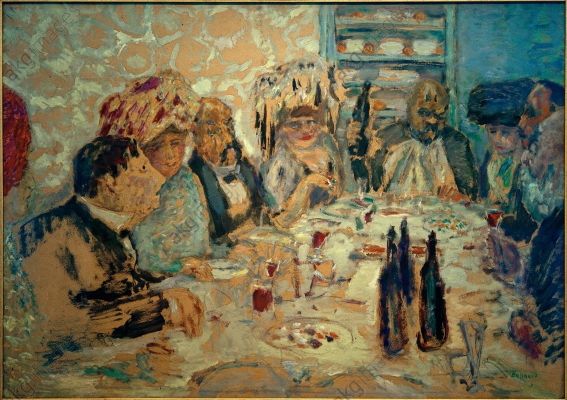
Dinner at Vollard's (Vollard's Cellar) (ca.1907)
Bonnard depicts a group seated around a table enjoying a splendid feast of food and wine. The man at the top of the table, holding aloft a bottle of wine, is the evening's host: Ambroise Vollard. A regular attendee of Vollard's notorious rue Laffitte cellar parties, the street photographer, Brassaï, recalled, "for thirty years, his famous cellar - a white vaulted room without a single picture on the walls - had been the center of Parisian artistic life. What joyful feasts, what parties and conferences, what planning sessions had been held there with all those artists, writers, critics, and collectors who were now famous".
Rendered in loose brushstrokes and bold coloring, the painting is representative of the decorative Post-Impressionist style to which Bonnard aligned. As a regular guest of the gatherings, Bonnard, evidently Vollard's favorite Nabis member, and the only one of the group whose paintings he collected, was hardly a neutral observer of the scene. As such, he was able to capture on canvas something of the energy and vitality of the gatherings. Speaking of this painting in particular, the curator Gloria Groom notes that "Bonnard gave the guests at Vollard's table only vague physiognomies, inviting numerous possibilities for identification. However, the artist stated "that the painting shows the German collector Count Harry Kessler, artists Odilon Redon and Jean-Louis Forain, and 'a severe-looking man, a manufacturer in business in the French Indies' [while others] have suggested that the guests include Degas". Groom records that the host bought the painting from Bonnard, and the fact that it "remained in Vollard's collection throughout his life suggests the personal meaning [it] held for him".
Oil on cardboard - Private Collection
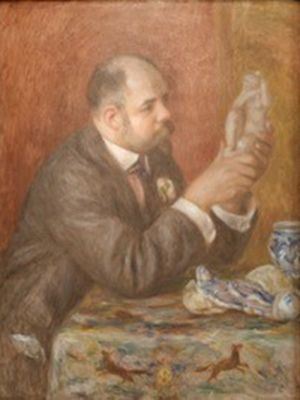
Ambroise Vollard (1908)
While Renoir painted or sketched Vollard on several occasions, this portrait best captures the essence of the man; a lover of art who was dedicated to his trade. Vollard is pictured in a brown suit, with loosened tie and ruffled pocket square, seated with his elbows resting on a covered tabletop. He adopts the demeanour of a working professional; here fully absorbed in the business of examining a small figurine. According to curator Rebecca A. Rabinow and art historian Jayne Warman the Vollard is pictured, "holding a statue by Maillol [...] who had been commissioned by Vollard to sculpt Renoir's likeness two years earlier".
Vollard first met the artist in 1894 when Renoir was at the height of his career and Vollard was just starting out on his. Renoir, who was already contracted to Durand-Ruel, supplied Vollard with smaller pieces - pastels and sketches - to sell. Vollard counted many artists as friends but, as the curator Anne Distel notes, "of all the Impressionists", Renoir was the artist who "would forge the most lasting bond with Vollard" with the two men remaining close until the artist's death in 1919. Indeed, Vollard had a significant impact on creating Renoir's legend, not only by promoting his art through sales in his gallery, but by encouraging him to enter the field of wax sculpture (after arthritis had forced the artist to move from the capital to the sunnier climes of southern France in 1908) and by memorializing his career through his 1919 monograph La Vie et l'oeuvre de Pierre-August Renoir.
On a more good-humoured note, Vollard told the tale of how Renoir had asked him to pick up a toreador costume whilst on a business trip to Spain. Vollard had one specially tailored and on his return Renoir asked his friend to sit in it for a portrait. One of several portraits of himself, Vollard's toreador portrait was not offered for sale, however, and took pride of place rather on a wall in his mansion.
Oil on canvas - Collection of Courtauld Institute of Art Gallery, London
Ambroise Vollard (1910)
The relationship between Vollard and Picasso was ambivalent but long lived. Vollard gave Picasso his first show (with Francisco Iturrino) in Paris in 1901; the Spaniard still aged just nineteen. The dealer wrote off the exhibition as a failure, though in fact many works did sell, albeit at lower prices that the artist would have liked. According to curator Ann Dumas, once he had become an established artist, "Picasso would later complain that the dealer [when he was first starting out] had bought the contents of his studio for a derisory sum, although, as the artist's friend Jacques Prévert was quick to remind him, the prices offered were not notably low at the time for work by an unknown name".
Vollard did buy several pieces from Picasso's Blue and Rose periods in 1906 having noticed that American collectors Gertrude and Leo Stein were taking a keen interest in the artist's work. In 1910, by which time Picasso's Cubist technique was moving more and more towards abstraction, Vollard mounted a retrospective of his works that emphasized his pre-Cubist period. That exhibition came at a time when Picasso's reputation was in the ascendence and the artist was looking for a primary dealer. He painted portraits of several leading candidates, including this treatment of Vollard. The portrait is a celebration of the artist's Analytical Cubist style, with the sitter rendered through a series of geometric shapes and planes. While most of the portrait is rendered in shades of brown, including his suit jacket, the viewer's eye is drawn to the dealer's facial features and his pronounced bald head which is painted in a vibrant gold. Though he described the portrait as "notable", Vollard was rather unmoved and sold it to a Russian collector in 1913. For his part, Picasso stated, "the most beautiful woman who ever lived never had her portrait painted, drawn, or engraved any oftener than Vollard - by Cézanne, Renoir, Rouault, Bonnard, Forain, almost everybody in fact. I think they all did him through a sense of competition, each one wanting to do him better than the others. He had the vanity of a woman, that man [...] my Cubist portrait of him [...] is the best one of them all".
In the 1920s and 1930s, Vollard commissioned from Picasso several livres d'artiste for his print series. It was in part the result of Vollard's publication of engravings and illustrated books that the Spanish master's profile rose significantly in Europe and America. Yet it was on the understanding, only made possible by Vollard's intervention in the first place, that Picasso became the natural heir to Cézanne. It is on this art history "orthodoxy" that Picasso's place has been secured in the pantheon of European modernists.
Oil on canvas - Collection of Pushkin State Museum of Fine Arts, Moscow
Biography of Ambroise Vollard
Childhood and Education
The first son of Marie-Louise-Antonine Lapierre and Alexandre Vollard, Ambroise Vollard was the eldest of ten children. Raised in the French colony of Réunion, an island in the Indian Ocean, he endured a strict childhood. His father was a serious man who worked in an official capacity as a notary clerk. Alexandre set high moral standards for his children with Ambroise recalling how as a twelve year old boy he was forbidden from reading Hans Christian Andersen's fairy-tale The Emperor's New Clothes because it featured a naked man. According to the art historian Ann Dumas, Vollard found an escape in collecting. She wrote: "a boy with a precocious visual sense, he delighted in the variety of tones in an all-white bouquet; his accumulations of pebbles and bits of broken blue crockery were early signs of a collecting instinct".
Early Training
Vollard had planned a career in medicine. However, once his father had taken him to a hospital to observe a live surgery, and when the sight of blood had nearly caused him to faint, his father decided Ambroise might be better suited to a career in law. Having spent two years studying in Montpellier, Vollard continued his training in Paris, of which he recalled, "Paris! The very magic of the name predisposed me to admire everything". It was in Paris that his love of art took hold, spending his downtime hunting, according to Dumas, "through boxes of books, prints, and drawings at the stalls along the quais of the Seine". Within the year Vollard gave up law and decided to become an art dealer; a decision which angered his father who responded by withdrawing his allowance.
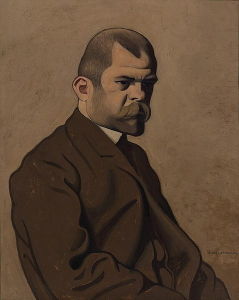
Having been turned down for an apprenticeship by the dealer Georges Petit (on the grounds that he spoke no foreign languages) Vollard worked briefly for the dealer Alphonse Dumas who specialized in academic painting and who actively discouraged Vollard's interest in Impressionism. In 1890 Vollard took the bold decision to go out on his own, opening a small shop in one of the two rooms he had rented as his lodgings. He initially struggled to earn a living, reselling artworks he had bought from the stalls that lined the banks of the Seine. Lacking the income needed to purchase important paintings, he showed incredible foresight and ingenuity by buying up prints and drawings by the lesser known "Seine" artists, the sale of which helped him accrue funds and even tie artists to contracts. In September 1893 Vollard moved into a small shop at 37 rue Laffitte, putting him in the vicinity of many of Paris's key galleries. Dumas notes that the opening of the gallery was well timed since it coincided with "the decline of the unwieldy state-sponsored Salon system, which was centered around large, annual exhibitions that were highly publicized" only to be overtaken by "the rise of the commercial dealer".
Vollard's first important break came when, operating on instinct, he took it upon himself to visit Édouard Manet's widow from whom he purchased a selection of her husband's unfinished paintings and drawings. These he presented to rave reviews at his first full gallery exhibition in 1894. The exhibition drew the attention of Edgar Degas and Pierre-Auguste Renoir who were so impressed with Vollard they agreed to have him represent them. Vollard's status as a dealer to be reckoned with was duly secured and he began to attract the attention of many influential collectors.
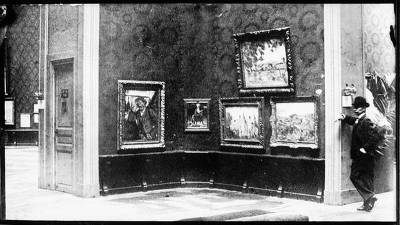
Speaking of Vollard's relationship with Cézanne, journalist Susan Stamberg explains how the artist, who had "not exhibited in 20 years" and was "living in obscurity" in Provence, was tracked down by Vollard (after first seeing one of his paintings in the window of Père Tanguy's shop) who bought up "150 canvases" from Cézanne's son, who was his business manager. Dumas adds that Vollard was "opportunistic enough to recognize Cézanne as the only major figure of the Impressionist generation without a dealer". She adds that the 1895 exhibition would be a crucial turning point in the dealer's career since it enabled him to "become Cézanne's sole dealer and thus gain a monopoly on his output; this, together with the fact that Vollard had begun to attract sophisticated French and international customers, laid the foundation for his subsequent success".
Once settled at 37 rue Laffitte, Vollard sought to consolidate his reputation as a dealer of avant-garde art with an exhibition of about twenty artworks by the likes of Paul Gauguin, Vincent van Gogh and Émile Schuffenecker. The exhibition was only a minor critical and commercial success but that didn't deter Vollard from holding a dedicated van Gogh exhibition in the following year featuring works borrowed from the recently deceased (1890) Dutchman's estate. The general public was yet to be won over by van Gogh's works and, disappointed in the lack of sales, Vollard never hosted another full exhibition of the Dutch artist's work. It would prove to be one of Vollard's most regrettable professional misjudgements: "I was totally wrong about van Gogh!", he said later, "I thought he had no future at all, and I let his paintings go for practically nothing". Despite the negligible returns, Vollard did help keep van Gogh's work in the public eye and can therefore take some small credit for securing his building reputation as a Post-Impressionist master.
Mature Period
As his reputation soared, Vollard moved to a larger shop on rue Laffitte; premises that would soon become one of the most important galleries in Paris. Vollard would host several solo exhibitions of key artists' here, including an 1898 exhibition of Paul Gauguin's Tahiti paintings, and the first solo shows by Émile Bernard (in 1901), Aristide Maillol (in 1902) and Henri Matisse (in 1904). But perhaps the most notable of these exhibitions came in 1901 when Vollard gave a nineteen-year-old Pablo Picasso his first exhibition. Vollard followed this in 1910 with a comprehensive exhibition of the Spaniard's pre-Cubist works.
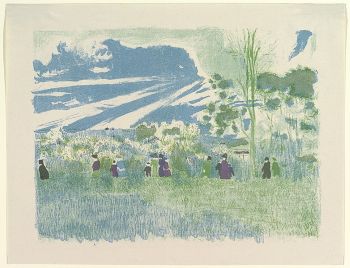
Through his gallery, Vollard was also responsible for promoting the artists associated with the relatively unknown Fauvist and Nabis movements. This came about in part through his interest in printmaking, and he encouraged artists such as Maurice Denis and André Derain to create prints which he then exhibited at his gallery. Vollard stated, "I was hardly settled in the rue Laffitte when I began to dream of publishing fine prints, but I felt they must be done by 'painter-printmakers.' My idea was to obtain works from artists who were not printmakers by profession". Impressionist Camille Pissarro, who had been represented by Vollard, praised the ingenuity of the dealer stating, "Vollard is going to have a press for lithographs in his place, rue Laffitte. This Creole is amazing; he wheels from one thing to another with startling ease". His first album of engravings, the successful, Les Peintres-Graves, published in 1896, included twenty-two original prints by a number of significant artists including Pierre Bonnard, Edvard Munch, Pierre-Auguste Renoir and Odilon Redon.
The rue Laffitte gallery would double as a social hub where the Parisian "in crowd" gathered to enjoy fine dining. As Dumas explains, these meals were "held in its cellar, the legendary cave, where Vollard served his native Creole chicken curry to a galaxy of artists, writers, and some of the more unconventional collectors. These celebrated gatherings were captured in paintings and sketches by [Pierre] Bonnard". On any given evening, one could dine with some of the most important people in Parisian society with often unexpected occurrences. For instance, Vollard describes one incident involving a guest who introduced his dinner partner as the holy Sister Marie-Louse. Vollard introduced her to Renoir, but was shocked to learn that she was not actually affiliated with the church at all. He recalled, "when I apologised to Renoir for having brought him into contact with a false nun, he replied: 'Wherever else I go, Vollard, I can say that I know beforehand whom I shall meet, and what we shall talk about. At your place one does at least meet with the unforeseen".
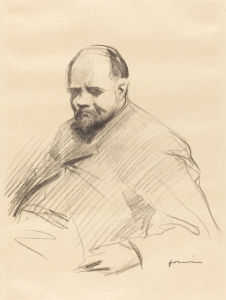
Never married, Vollard came to view his artists community as his family amongst whom made an imposing presence: "exceptionally tall and heavily built [with] darkish skin and heavy-lidded eyes", writes Dumas, Vollard spoke with a "slight lisp, in a voice surprisingly light and high-pitched for a man of his bulk", while his "unhurried and ponderous" movements belied his astute business savvy. Otherwise, stories of Vollard's private life are scarce and anecdotal with even his autobiography focusing almost exclusively on associations with his colleagues and peers (there is nothing at all relating to any romantic relationships Vollard may have pursued). He did, however, offer an interesting aside on the idea of taking a spouse when he stated, "I have always appreciated-where others are concerned-the usefulness of being married. If you are asked to do something that bores you: [you can say] 'My wife won't hear of it!".
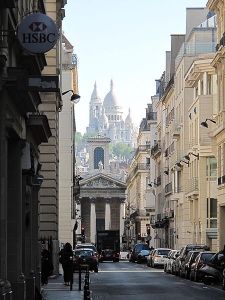
Vollard was not without his distractors and it is known that he was given to sudden mood swings and bouts of morose silence. The renowned writer and collector Gertrude Stein once described him as a "huge dark man"; and that was when he was in a "cheerful" mood. The curator Gary Tinterow added that Vollard could be a thoroughly obstinate man who "would never sell anybody what they wanted: he would never show people what they wanted. If they came in to see a Cézanne, he would bring out a Gauguin. If they wanted a still life, he would say, 'Well, here's a landscape".
There were also the inevitable disagreements between dealer and artist. Museum director Douglas Druick explains how early in their relationship Gauguin "frequently expressed vehement hostility to Vollard in letters to friends" and was often critical of the commission he took as a dealer. And yet some of these disagreements were no doubt due as much to his artists' personalities and expectations as to those of Vollard as their dealer. As Dumas explains, "Vollard was full of contradictions, and opinions of him differed widely. Artists who complained that he exploited them found a convenient pun equating his name with the word voleur, meaning 'thief' [but] others valued his loyalty and generosity. 'I believe absolutely in Vollard as an honest man,' insisted Cézanne, who was eternally grateful to Vollard for rescuing him from obscurity". Vollard and Renoir would, meanwhile, become lifelong friends.
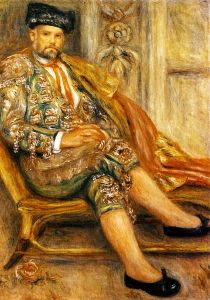
As much a friend as a dealer, Vollard sat for many portraits. These ranged from simple sketches to Cubist canvases by artists including Cézanne, Denis, Picasso, Renoir and Georges Rouault. While they varied in treatment, all were engaged in trying to capture something of the enigma of this guarded and private man.
Vollard proved to be a somewhat restless figure when it came to his creative interests. When reflecting on his move into publishing he supplied the following anecdote: "strolling along the quays, I dipped one day into the books in a second-hand dealer's box. On the title-page of a fine octavo I read: Ambroise Firmin-Didot, éditeur. 'Ambroise Vollard, éditeur ... that wouldn't look bad either,' I thought. Little by little the idea of becoming a publisher, a great publisher of books, took root in my mind. I could not see a fine sheet of paper without thinking: 'How well type would look on it!". Vollard soon directed all his energies into this new pursuit, with the books he published designed to include illustrations by the artists he represented. In 1916, he published an revised edition of Charles Baudelaire's Les Fleurs du Mal which included illustrations by Émile Bernard; a controversial choice given that the first edition of the book (published in 1856) prompting a national scandal in which a court found six of the poems to be indecent and ruled that they be removed from all future editions.
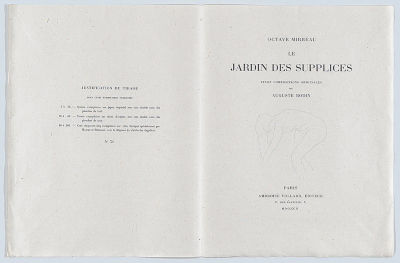
Having become a successful art dealer and book publisher, Vollard took up the pen himself: "not satisfied with being a publisher, I tried my hand at writing as well", he wrote. He wrote monographs on key artists, starting with Cézanne in 1914. Of the process of writing his first book, Vollard enthused, "in the joy of seeing myself in print, I hung about the machines all day". He followed with books on Renoir in 1919 and Degas in 1924. As he was personally acquainted with all these artists the books carried a certain authenticity in their insights. For his book on Renoir, Vollard stated, "I gave a great deal of space to painting, though merely, I must add, as a reporter of Renoir's sayings on the subject. But here also the person and life of the artist deserved the fullest treatment I could give them". Commenting on the books a century on, Dumas observed that though "anecdotal and in many ways lightweight, these books nonetheless retain the freshness of firsthand accounts, and art historians have relied on them as a unique fund of information".
Later Period
The outbreak of the first world war forced Vollard (like other dealers) to close his gallery and to retreat to the commune of Varaville in Normandy (northwest France). He remained active, however, managing to sell a few paintings and, at the behest of the French government's Propaganda Services, touring Switzerland and Spain to lecture on (French) artists Cézanne and Renoir.
After the war, Vollard was able to reinvent himself. The center of the Paris art world had moved to an area close to the Champs-Élysées but Vollard chose to pursue a different path as a private dealer, promotor and book publisher working from his own residence. According to Dumas, in 1924 he purchased a former hotel which, with its many rooms, could accommodate his sizable collection of artworks. He turned the first floor into a gallery where he could exhibit and sell works. Vollard's prestige was now such that he signed with an English publisher to write his autobiography, Recollections of a Picture Dealer. It was so well received when it debuted in 1926 that a French edition was published a year later. He made his one and only visit to the United States in late October of 1936 where he gave a lecture at a New York City gallery in conjunction with a Cézanne show, as well as a talk at the Barnes Foundation in early November, most likely to further the relationship with Albert Barnes who had been a patron at Vollard's Paris shop.
Shortly after the outbreak of World War II, the 73-year-old Vollard was involved in a car crash. He was the only passenger in his chauffeur driven car making a return trip to Paris form his home in Tremblay-sur-Maudre. He died the following day in the hospital from complications resulting from the accident. In his will, Vollard left everything to his brothers and sisters, a family friend, and a few works to the City of Paris (the latter setting up a room dedicated to Vollard at the Musée du Petit Palais in 1940). While Vollard had amassed an impressive collection of modern art, there was no definitive record of what he did or did not own outright and a significant number of works "disappeared" during the war years. As a result, several scandals and lawsuits followed concerning the distribution and legal ownership of his collection. These legal squabbles have extended well into the twenty-first century.
The Legacy of Ambroise Vollard
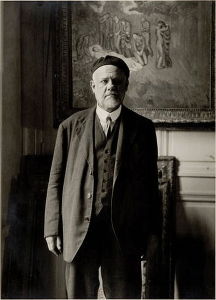
There can be little doubt that Vollard made a significant impact on early twentieth century art. According to Dumas, "he rapidly became the leading contemporary art dealer of his generation and a principal player in the history of modern art [helping launch] the careers of Paul Cézanne, Pablo Picasso, and the Fauves [not to mention] the Nabis, Odilon Redon, Henri Matisse, and many others". Of his Cézanne exhibitions alone, curator Rebecca A. Rabinow states, "if you think about all the people who passed through Vollard's gallery, all the artists who became influenced by Cézanne. Had Vollard not tracked him down in the south of France, would cubism even exist?".
Vollard set the standard for what an art dealer could achieve. If one takes the example of Cézanne alone, Vollard showed how self-belief and a special faith in an (unknown) artist - evidenced in his purchase of a whole portion of his work - could influence the future tastes of a generation. Vollard also refused to be held down by the narrow definition of "art dealer"; expanding his influence into publishing and illustration. As an author himself, his monographs on Cézanne, Degas and Renoir are to this day highly regarded as primary sources by historians. Furthermore, he encouraged many of his clients to take up the art of printmaking including Pierre Bonnard and Édouard Vuillard, the latter, according to Dumas, playing "a key role in the rebirth of printmaking (particularly the emergence of the color lithograph) that took place at the end of the nineteenth century".
![The Fontaine [fountain] des Bagniers, locate on the rue des Chapeliers in Aix-en-Provence, France was a gift to the city from Vollard in 1926. In the center is a medallion featuring a portrait of Paul Cézanne which was drawn by Auguste Renoir.](/images20/photo/photo_vollard_ambroise_9.jpg)
Some have noted that Vollard failed to exploit the full potential of Matisse or Picasso, while he remained largely unresponsive to some of the major movements including Cubism and Surrealism. Yet these shortcomings were more than outweighed by Vollard's dedication to his artists' development and a level of persistence and self-belief that saw him shape the canon of turn-of-the-century modernism.
Influences and Connections

-
![Guillaume Apollinaire]() Guillaume Apollinaire
Guillaume Apollinaire -
![Gertrude Stein]() Gertrude Stein
Gertrude Stein ![Leo Stein]() Leo Stein
Leo Stein- Albert Barnes
- Louise Havemeyer
-
![Guillaume Apollinaire]() Guillaume Apollinaire
Guillaume Apollinaire -
![Gertrude Stein]() Gertrude Stein
Gertrude Stein ![Leo Stein]() Leo Stein
Leo Stein- Albert Barnes
- Louise Havemeyer
 Ask The Art Story AI
Ask The Art Story AI



















